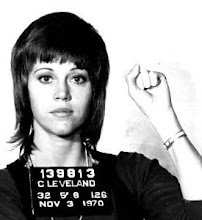Feminism(s) in the Third Wave

Here's the aforementioned proposal. They have extended the deadline, so I would appreciate any comments, if there are points that need editing or further clarification. I need to cut 100 words out of this proposal, so what is extraneous. Obviously, I haven't written the essay yet so the ideas are not honed...
=======
From SCUM to Cyber-feminism: A Geneology of the Feminist Manifesto
During the late 1960s and 1970s there was a proliferation of writing by women on women’s experiences and feminism. The Radical Women Manifesto (1967), Valerie Solanas’s “SCUM Manifesto” (1968), Jo Freeman’s “Bitch Manifesto” (1972), and Helene Cixous’s proposal of an écriture feminine in “Laugh of the Medusa” (1975), all garnered excited scholarly and public interest.
The question my paper will pose is: Where are the feminist manifestos of the 21st Century? Consider Ariel Levy’s recently published book “Female Chauvinist Pig” which could be called anti- or post-feminist, and Maureen Dowd’s much e-mailed New York Times article from October 2005 titled “What’s a Modern girl to do?”. While these texts examine issues such as the pseudo-pornographic sexuality of women in pop culture, they lack any clear momentum in terms of a positive direction for feminist activism. Most importantly, these authors write as though feminism is over. It is not--feminism is a plural, changeable entity. There is no unified identity in feminism just as there is no unified identity in “woman”. There is a notion in general society that the work force is now open to all women (though we are still struggling to legislate equal pay for equal labour), and that women can choose whether or not to adopt their husbands’ names (hetero-normative IS the norm), and therefore feminism has served it’s purpose. It is in this gap that young feminists must, and do, insert themselves. Third Wave grrrls draw on the work of feminists preceding them and continue to act for change. ACT is the key word here: today’s (young) feminism is an activist feminism, concerned with a DIY ethics of demonstration and dissent.
So where are the Third Wave manifestos, the calls to action? No longer distributed by the commercial forces of organized publishing, my paper will argue that the Third Wave feminist manifestos are found online. Anticipated by the VNS Matrix in the early nineties with their “Cyber-feminist Manifesto for the 21st Century”, today’s young feminists are the inheritors of Solanas’s self-published rants. Blogs, webpages, and online communities such as Feministe , Blackfeminism.org and Bitch Ph.D are just a few examples of the wide presence of cyber-feminists. In examining several blogs and webpages dedicated to critiquing mass-culture and putting forth feminist activism, I will argue that in utilizing the non-linear, non-hierarchical, and user-friendly interface of the internet Third Wave feminists combine écriture feminine with a DIY ethics. Instead of having one or two major writers disseminating their knowledge via mainstream presses, young feminists are creating a rhizomatic network that is accessible to all. An important caveat of my main question must be: What does a feminist manifesto accomplish? A manifesto is a call to action, a solidifying of a position, and builds community. These are all essential if any action is to succeed, and my paper will demonstrate that feminist bloggers are in fact fostering online communities of action.
Labels: feminism, literature






